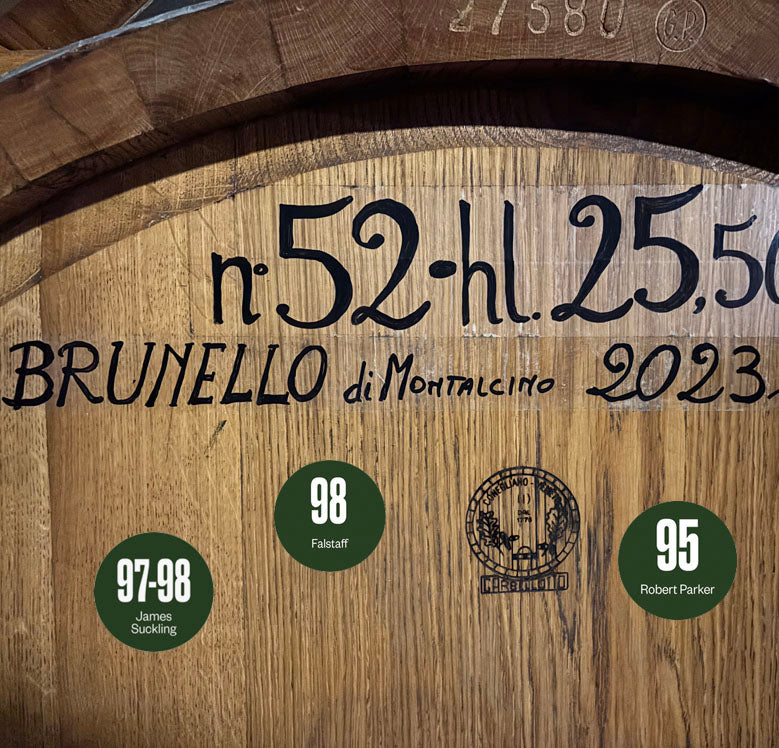What's the best Brunello? (And why that answer changes every year)

There's no such thing as the "best" Brunello di Montalcino. In a great vintage, producer A might shine, while the next year, producer B excels. Moreover, taste plays a key role: what one person considers the ultimate Brunello might be too powerful, too elegant, or too modern for another. However, there are icons, trusted critics (such as Parker and Suckling), and smart choices in the best value category.
Why There Is No Single Best Brunello
1) Vintage sets the bar
Brunello is extremely sensitive to weather. Temperature, rainfall, wind, and harvest time influence structure, ripening potential, and aroma. This is why the same producer can achieve stellar results one year and "only" excellent results the next.
2) Terroir and style
Montalcino has distinct microclimates (north vs. south, elevation differences, exposure). Some estates vinify traditionally (larger bottles, longer aging), while others use more modern methods (more new oak, riper fruit). The style you prefer largely determines what you consider "the best."
3) Your taste profile
-
Do you like classic Brunellos: tar, roses, cherries, fine acidity, tighter tannins?
-
Or rather modern Brunellos: riper fruit, velvety texture, a little more wood spice?
-
Are you drinking now or would you rather put it aside for 10–20 years ?
How useful are Parker and Suckling's scores?
Reviewers like Robert Parker's Wine Advocate and James Suckling provide guidance: they taste extensively, are consistent, and communicate clearly. This is a useful tool for comparing vintages and producers.
How to use them wisely:
-
Compare by producer and vintage , not between completely different styles.
-
Look at the tasting notes , not just the number: words like “racy acidity,” “firm tannins,” “silky texture” say a lot about the style.
-
Combine with your own taste and – if possible – tasting experience.
Tip: Think of high scores as a starting point , not an end point. Use them to create your shortlist and then choose based on style, occasion, and budget.
Icons you must know
While there is no such thing as the best Brunello, some names have been at the top for decades :
-
Biondi-Santi – The historic cradle of Brunello. Style: classic, refined, excellent aging potential.
-
Poggio di Sotto – Elegance and precision; often vibrant acidity, unprecedented layering.
-
Valdicava – Power and depth with a modern, luxurious touch; impressive in great vintages.
These wines often cost over €100 a bottle. Phenomenal for special occasions, but not within everyone's budget.
Best value for money: top picks among icons
Not everyone wants or can spend over €100. Fortunately, Brunello is rich in pearls with exceptional value for money , especially in good vintages.
We've selected a range of "Best Value Brunellos" that excel in balance, typicity, and consistency. View the current selection here:
👉 Best value Brunello's di Montalcino
Why this selection works for you:
-
Strict pre-selection based on typicity (Sangiovese-pur sang), balance and length.
-
Vintage Smart : We look at years in which producers excelled.
-
Style variation : from classic to more modern, so you can match it to your taste.
Quick guide: how to find your “best” Brunello
-
Determine the occasion
-
Drink now → choose a vintage that has already had some aging or a producer known for approachable tannins.
-
Storage → aim for structural years (firm tannins + high acidity).
-
Choose your style
-
Elegant/classic → more red fruit, higher acidity, leaner body.
-
Rich/modern touch → dark fruit, softer texture, a little more wood.
-
Read smart
-
Check Parker/Suckling notes for keywords (acidity, tannins, wood, body).
-
Filter by alcohol% (slightly lower = often leaner) and maturation in wood (more new wood = often rounder/vanillin).
-
Food pairing as a compass
-
Classic → pasta with ragù, mushroom risotto, grilled chicken, hard cheeses.
-
Rich → bistecca alla Fiorentina, game dishes, stew with spices.
Storage advice & serving tips
-
Serving : 16–18 °C, use large glasses; decant younger Brunellos for 1–2 hours .
-
Storage : Flat, cool, and dark. Top vintages/producers develop for 10–20 years or longer.
-
Mid-ripening (5–8 years): Often the sweetest point between primary fruit intensity and tertiary complexity.
Frequently Asked Questions (FAQ)
Is Brunello always 100% Sangiovese?
Yes. Brunello di Montalcino is 100% Sangiovese (local biotype).
What is the difference with Rosso di Montalcino?
Rosso ages for a shorter period and is generally fruitier and easier to drink; Brunello ages longer and is more complex and structured.
How important is the harvest year?
Very much. Vintage determines ripeness, acidity, and tannin structure. That's why "the best" shifts every year.
Can I buy blindly based on high scores?
Use scores as a guide, but always match with your style preference and occasion .
Need help selecting your perfect Brunello? Read our Ultimate Brunello Buying Guide here.
